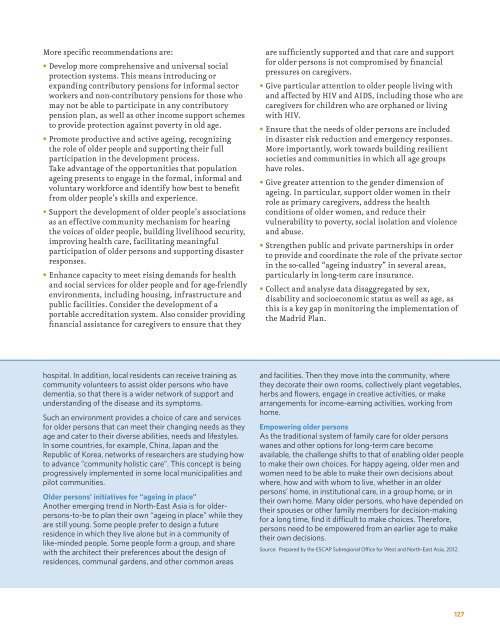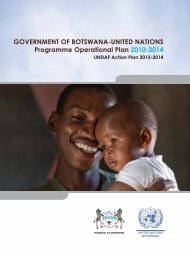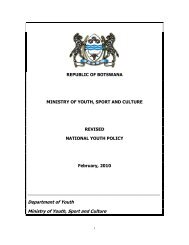Ageing in the Twenty-First Century: - HelpAge International
Ageing in the Twenty-First Century: - HelpAge International
Ageing in the Twenty-First Century: - HelpAge International
Create successful ePaper yourself
Turn your PDF publications into a flip-book with our unique Google optimized e-Paper software.
More specific recommendations are:<br />
• Develop more comprehensive and universal social<br />
protection systems. This means <strong>in</strong>troduc<strong>in</strong>g or<br />
expand<strong>in</strong>g contributory pensions for <strong>in</strong>formal sector<br />
workers and non-contributory pensions for those who<br />
may not be able to participate <strong>in</strong> any contributory<br />
pension plan, as well as o<strong>the</strong>r <strong>in</strong>come support schemes<br />
to provide protection aga<strong>in</strong>st poverty <strong>in</strong> old age.<br />
• Promote productive and active age<strong>in</strong>g, recogniz<strong>in</strong>g<br />
<strong>the</strong> role of older people and support<strong>in</strong>g <strong>the</strong>ir full<br />
participation <strong>in</strong> <strong>the</strong> development process.<br />
Take advantage of <strong>the</strong> opportunities that population<br />
age<strong>in</strong>g presents to engage <strong>in</strong> <strong>the</strong> formal, <strong>in</strong>formal and<br />
voluntary workforce and identify how best to benefit<br />
from older people’s skills and experience.<br />
• Support <strong>the</strong> development of older people’s associations<br />
as an effective community mechanism for hear<strong>in</strong>g<br />
<strong>the</strong> voices of older people, build<strong>in</strong>g livelihood security,<br />
improv<strong>in</strong>g health care, facilitat<strong>in</strong>g mean<strong>in</strong>gful<br />
participation of older persons and support<strong>in</strong>g disaster<br />
responses.<br />
• Enhance capacity to meet ris<strong>in</strong>g demands for health<br />
and social services for older people and for age-friendly<br />
environments, <strong>in</strong>clud<strong>in</strong>g hous<strong>in</strong>g, <strong>in</strong>frastructure and<br />
public facilities. Consider <strong>the</strong> development of a<br />
portable accreditation system. Also consider provid<strong>in</strong>g<br />
f<strong>in</strong>ancial assistance for caregivers to ensure that <strong>the</strong>y<br />
are sufficiently supported and that care and support<br />
for older persons is not compromised by f<strong>in</strong>ancial<br />
pressures on caregivers.<br />
• Give particular attention to older people liv<strong>in</strong>g with<br />
and affected by HIV and AIDS, <strong>in</strong>clud<strong>in</strong>g those who are<br />
caregivers for children who are orphaned or liv<strong>in</strong>g<br />
with HIV.<br />
• Ensure that <strong>the</strong> needs of older persons are <strong>in</strong>cluded<br />
<strong>in</strong> disaster risk reduction and emergency responses.<br />
More importantly, work towards build<strong>in</strong>g resilient<br />
societies and communities <strong>in</strong> which all age groups<br />
have roles.<br />
• Give greater attention to <strong>the</strong> gender dimension of<br />
age<strong>in</strong>g. In particular, support older women <strong>in</strong> <strong>the</strong>ir<br />
role as primary caregivers, address <strong>the</strong> health<br />
conditions of older women, and reduce <strong>the</strong>ir<br />
vulnerability to poverty, social isolation and violence<br />
and abuse.<br />
• Streng<strong>the</strong>n public and private partnerships <strong>in</strong> order<br />
to provide and coord<strong>in</strong>ate <strong>the</strong> role of <strong>the</strong> private sector<br />
<strong>in</strong> <strong>the</strong> so-called “age<strong>in</strong>g <strong>in</strong>dustry” <strong>in</strong> several areas,<br />
particularly <strong>in</strong> long-term care <strong>in</strong>surance.<br />
• Collect and analyse data disaggregated by sex,<br />
disability and socioeconomic status as well as age, as<br />
this is a key gap <strong>in</strong> monitor<strong>in</strong>g <strong>the</strong> implementation of<br />
<strong>the</strong> Madrid Plan.<br />
hospital. In addition, local residents can receive tra<strong>in</strong><strong>in</strong>g as<br />
community volunteers to assist older persons who have<br />
dementia, so that <strong>the</strong>re is a wider network of support and<br />
understand<strong>in</strong>g of <strong>the</strong> disease and its symptoms.<br />
Such an environment provides a choice of care and services<br />
for older persons that can meet <strong>the</strong>ir chang<strong>in</strong>g needs as <strong>the</strong>y<br />
age and cater to <strong>the</strong>ir diverse abilities, needs and lifestyles.<br />
In some countries, for example, Ch<strong>in</strong>a, Japan and <strong>the</strong><br />
Republic of Korea, networks of researchers are study<strong>in</strong>g how<br />
to advance “community holistic care”. This concept is be<strong>in</strong>g<br />
progressively implemented <strong>in</strong> some local municipalities and<br />
pilot communities.<br />
Older persons’ <strong>in</strong>itiatives for “age<strong>in</strong>g <strong>in</strong> place”<br />
Ano<strong>the</strong>r emerg<strong>in</strong>g trend <strong>in</strong> North-East Asia is for olderpersons-to-be<br />
to plan <strong>the</strong>ir own “age<strong>in</strong>g <strong>in</strong> place” while <strong>the</strong>y<br />
are still young. Some people prefer to design a future<br />
residence <strong>in</strong> which <strong>the</strong>y live alone but <strong>in</strong> a community of<br />
like-m<strong>in</strong>ded people. Some people form a group, and share<br />
with <strong>the</strong> architect <strong>the</strong>ir preferences about <strong>the</strong> design of<br />
residences, communal gardens, and o<strong>the</strong>r common areas<br />
and facilities. Then <strong>the</strong>y move <strong>in</strong>to <strong>the</strong> community, where<br />
<strong>the</strong>y decorate <strong>the</strong>ir own rooms, collectively plant vegetables,<br />
herbs and flowers, engage <strong>in</strong> creative activities, or make<br />
arrangements for <strong>in</strong>come-earn<strong>in</strong>g activities, work<strong>in</strong>g from<br />
home.<br />
Empower<strong>in</strong>g older persons<br />
As <strong>the</strong> traditional system of family care for older persons<br />
wanes and o<strong>the</strong>r options for long-term care become<br />
available, <strong>the</strong> challenge shifts to that of enabl<strong>in</strong>g older people<br />
to make <strong>the</strong>ir own choices. For happy age<strong>in</strong>g, older men and<br />
women need to be able to make <strong>the</strong>ir own decisions about<br />
where, how and with whom to live, whe<strong>the</strong>r <strong>in</strong> an older<br />
persons’ home, <strong>in</strong> <strong>in</strong>stitutional care, <strong>in</strong> a group home, or <strong>in</strong><br />
<strong>the</strong>ir own home. Many older persons, who have depended on<br />
<strong>the</strong>ir spouses or o<strong>the</strong>r family members for decision-mak<strong>in</strong>g<br />
for a long time, f<strong>in</strong>d it difficult to make choices. Therefore,<br />
persons need to be empowered from an earlier age to make<br />
<strong>the</strong>ir own decisions.<br />
Source: Prepared by <strong>the</strong> ESCAP Subregional Office for West and North-East Asia, 2012.<br />
127







